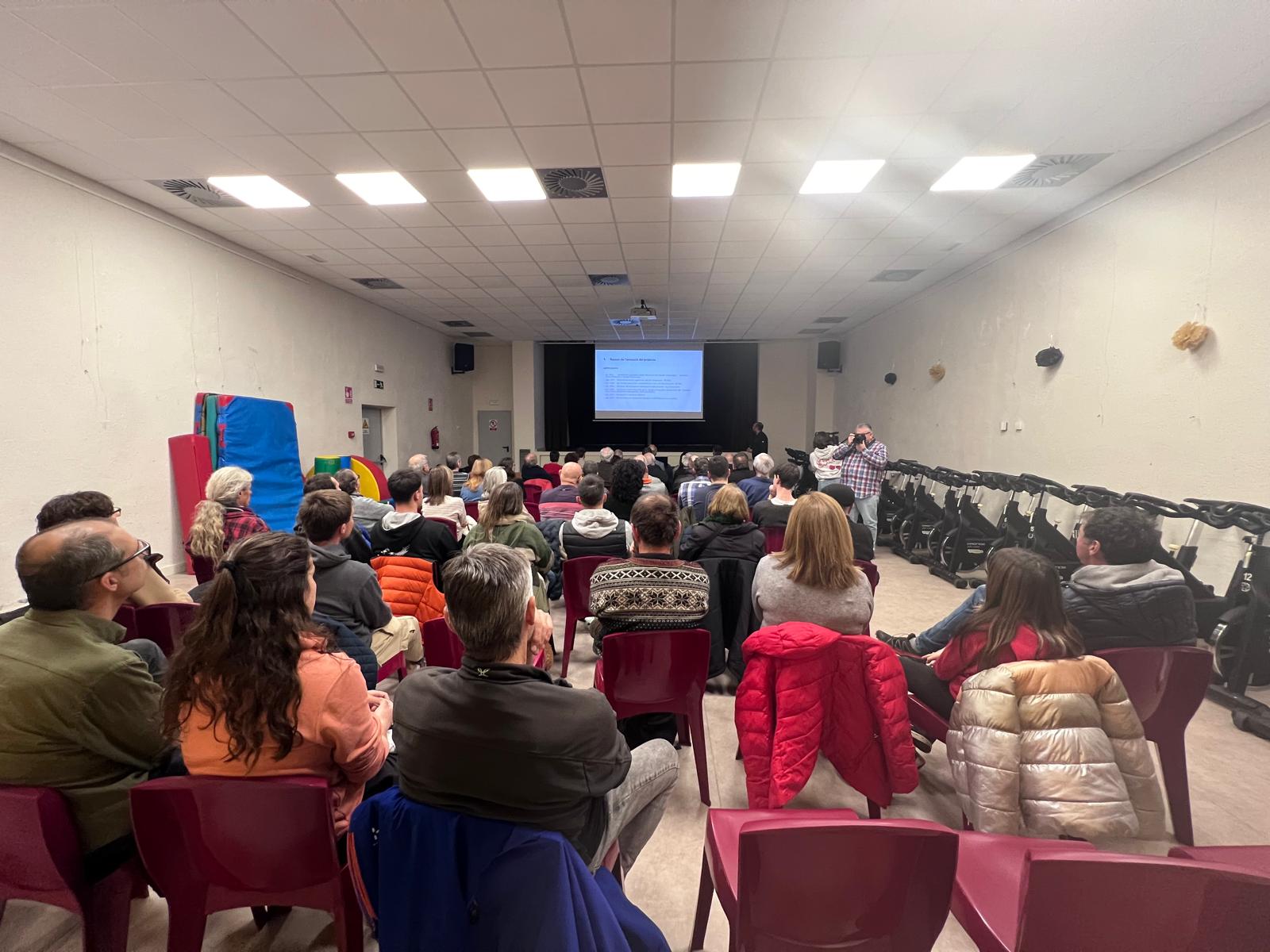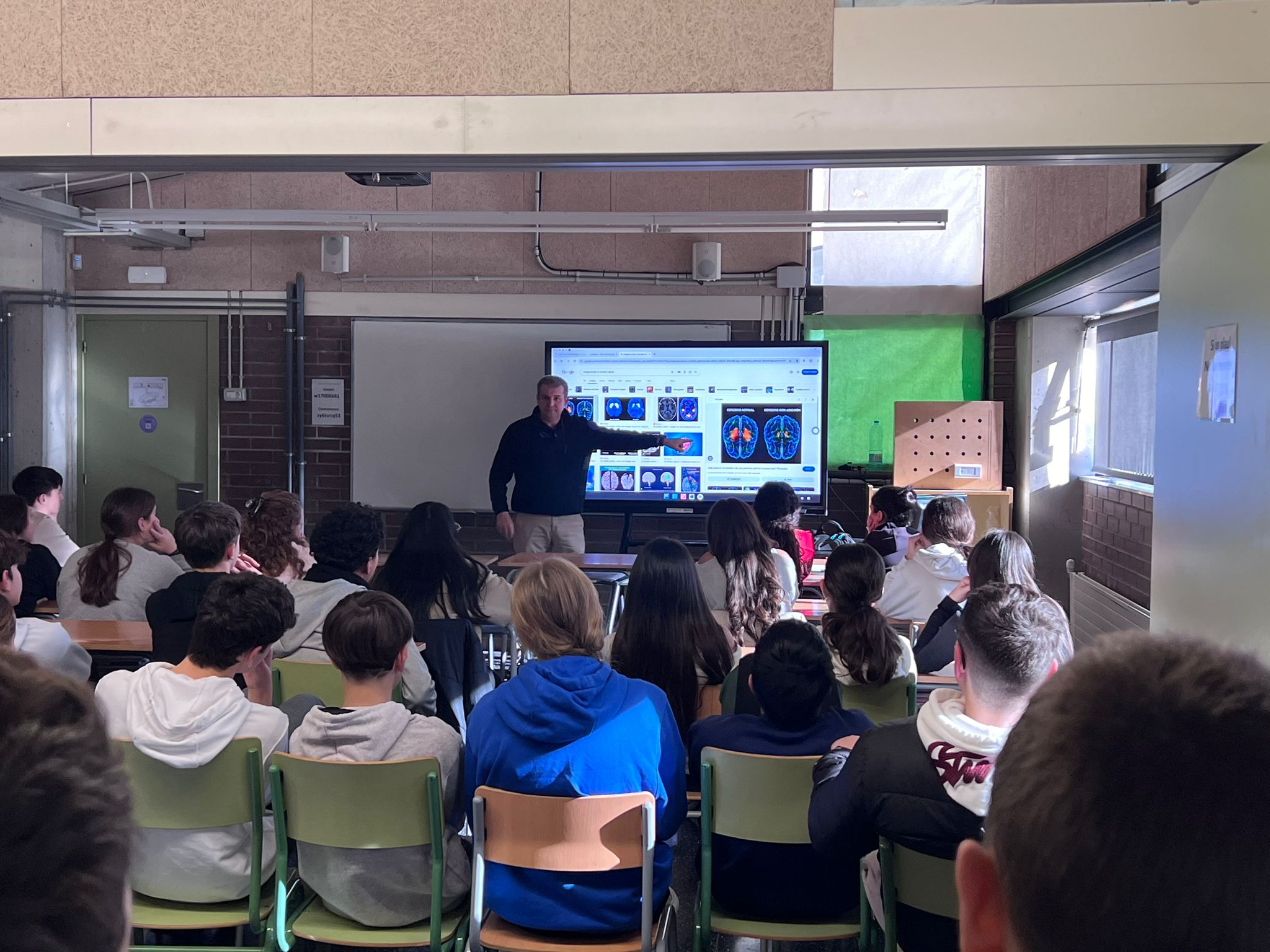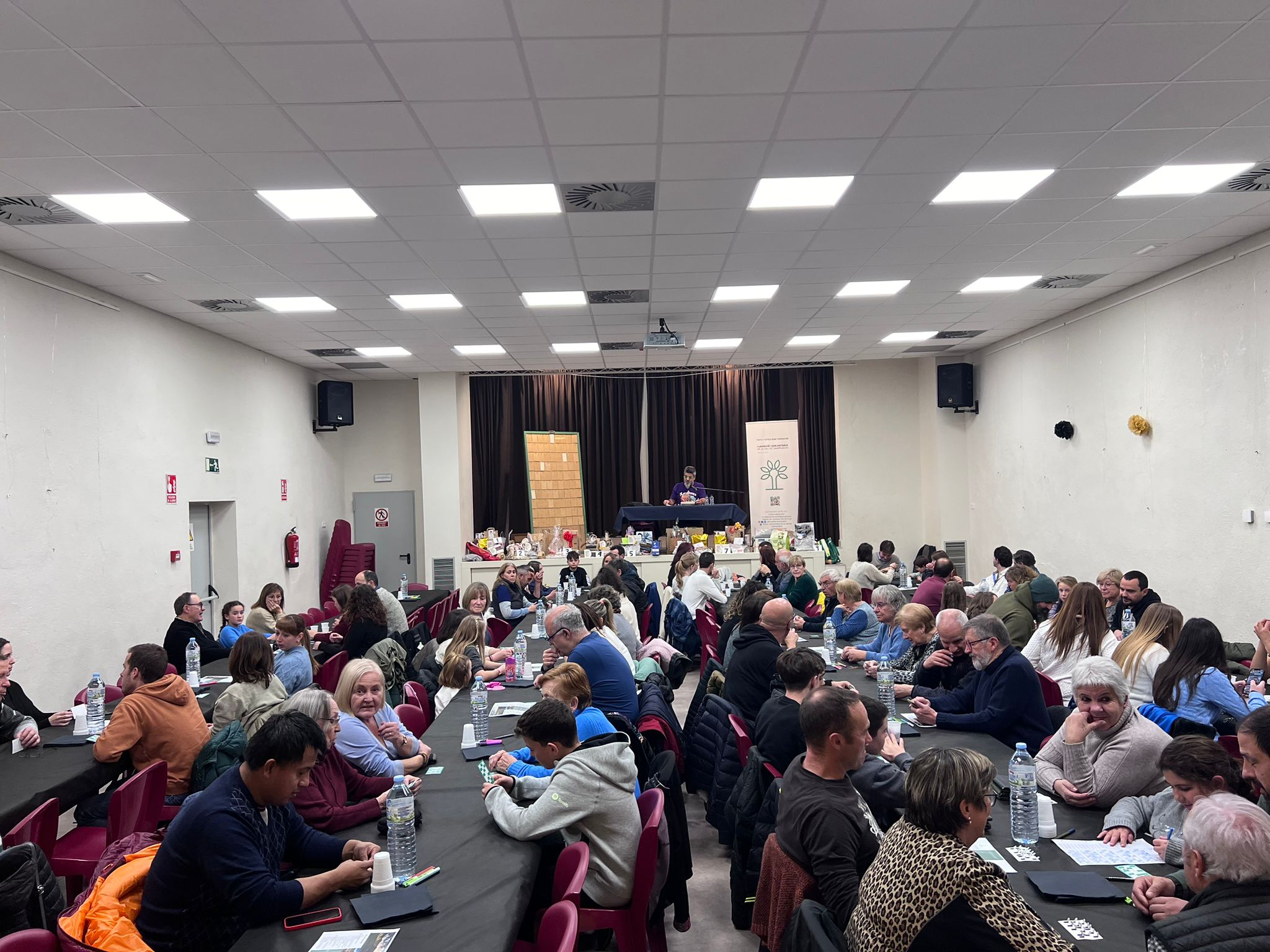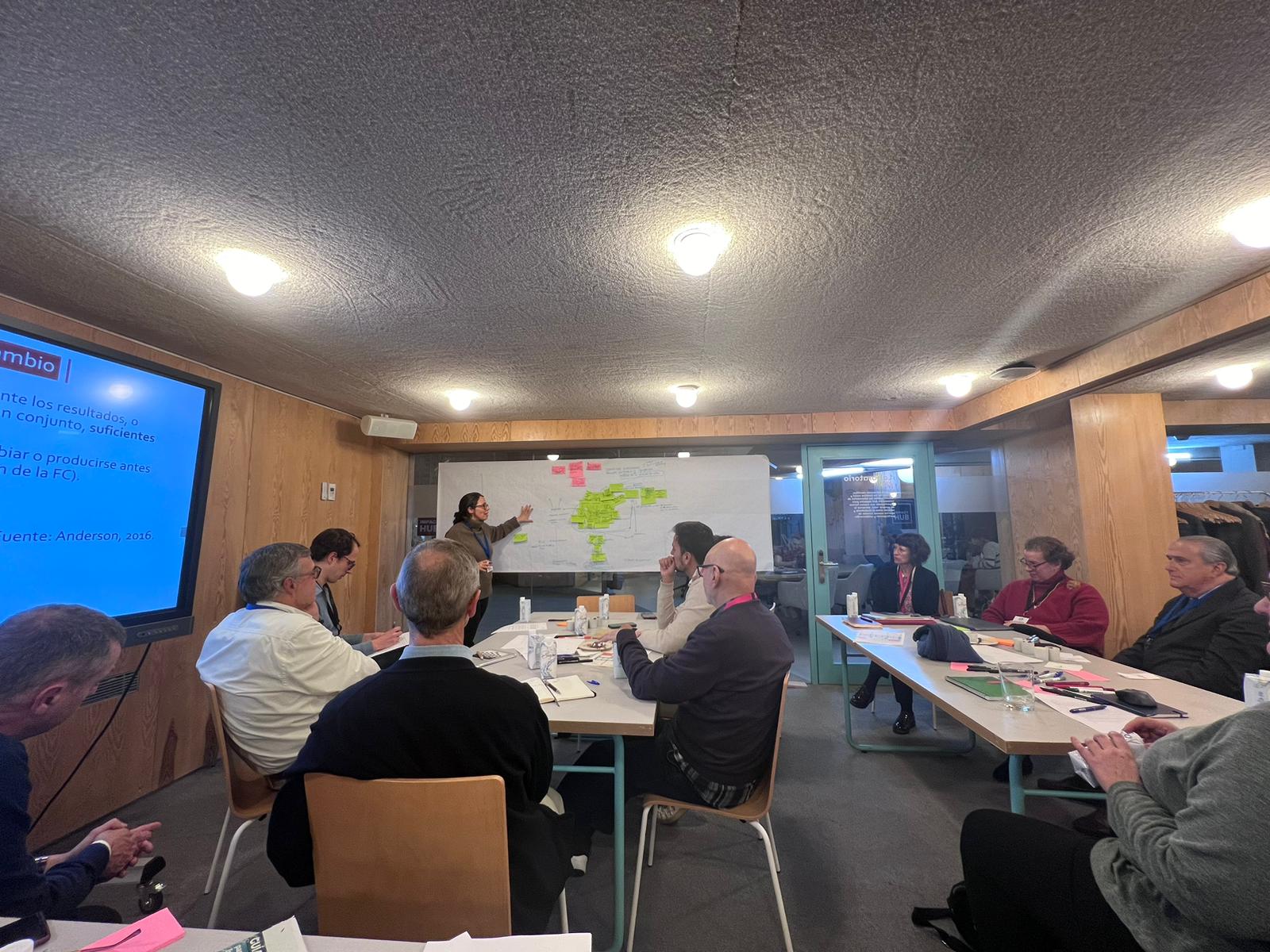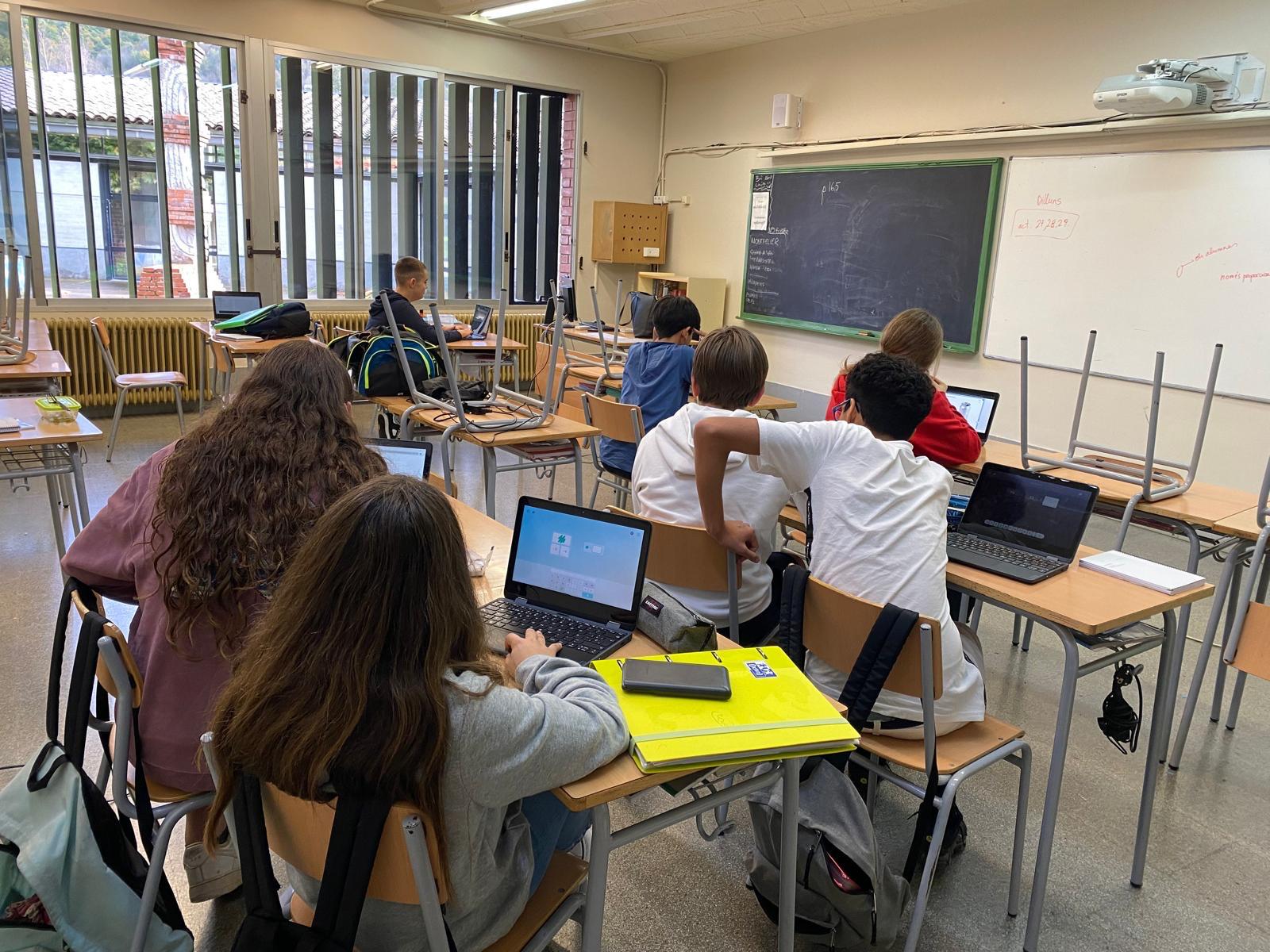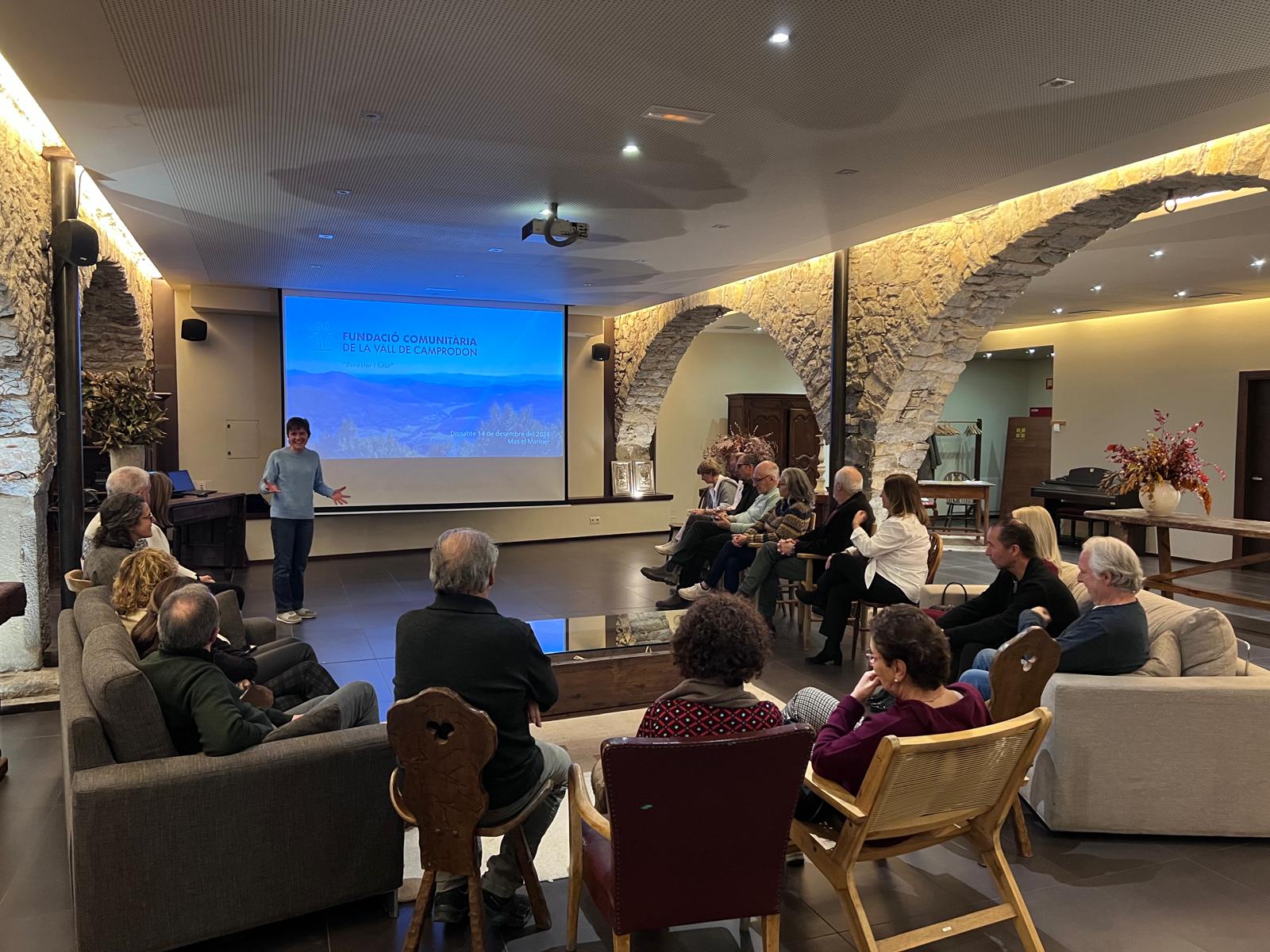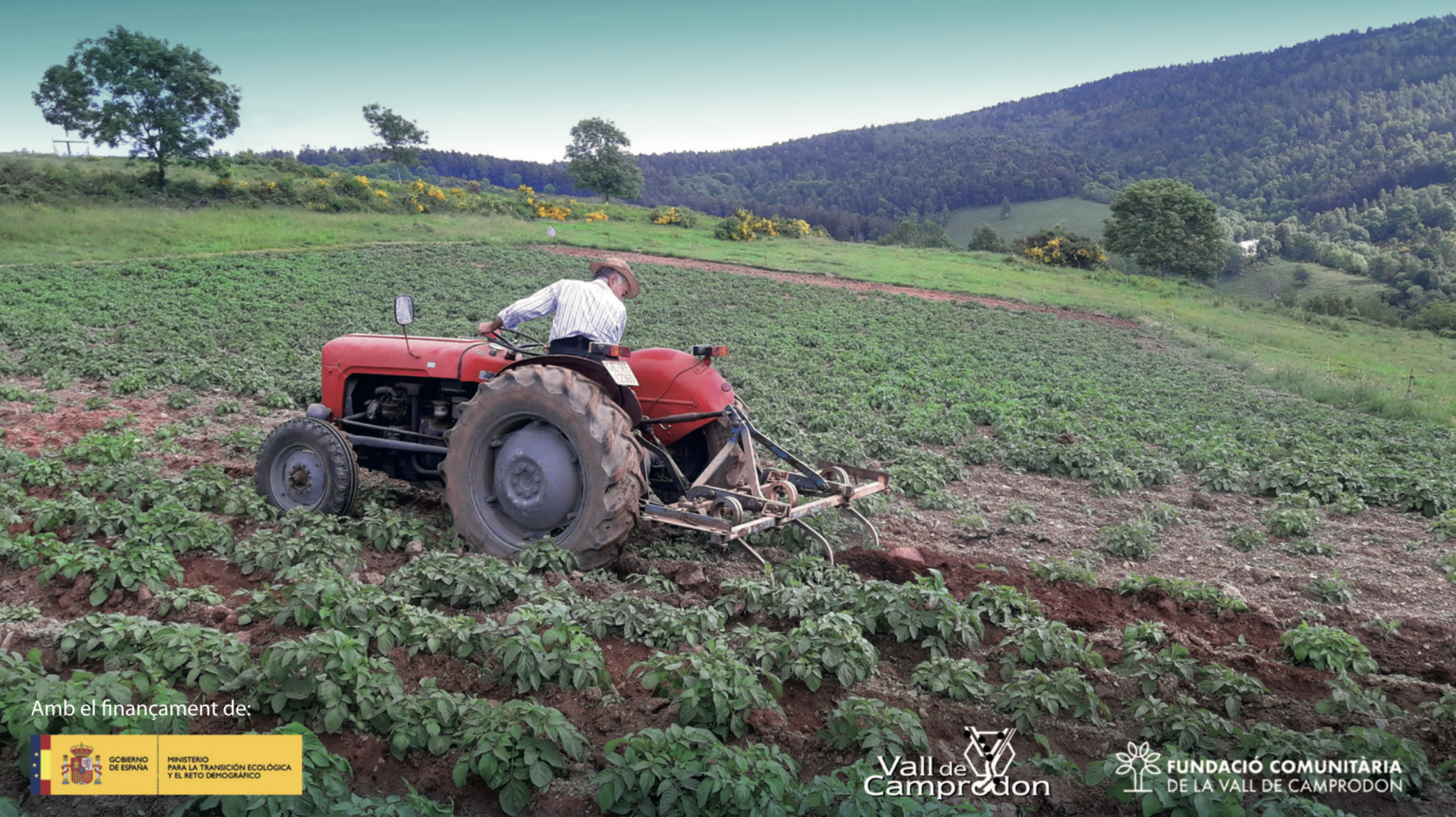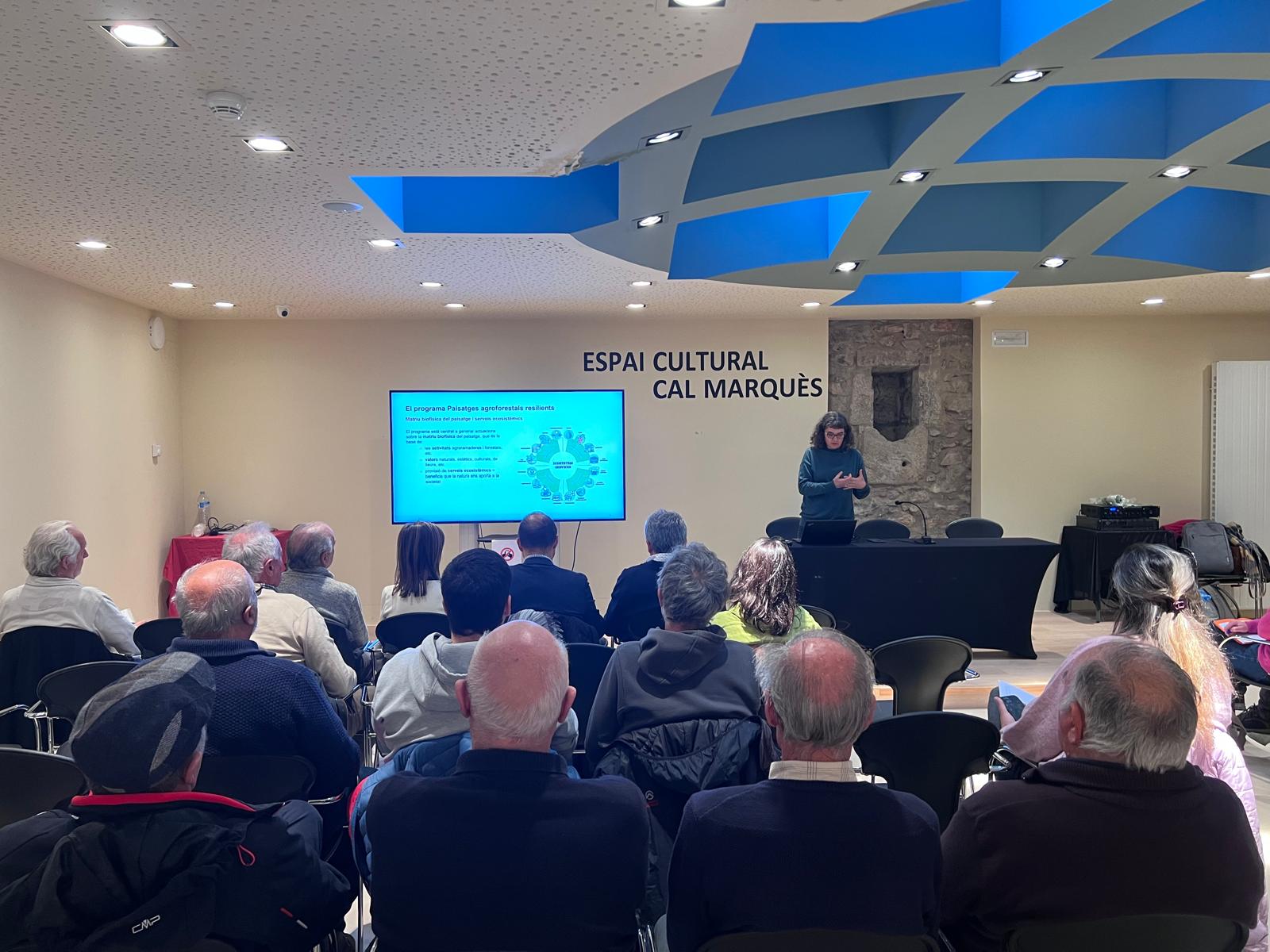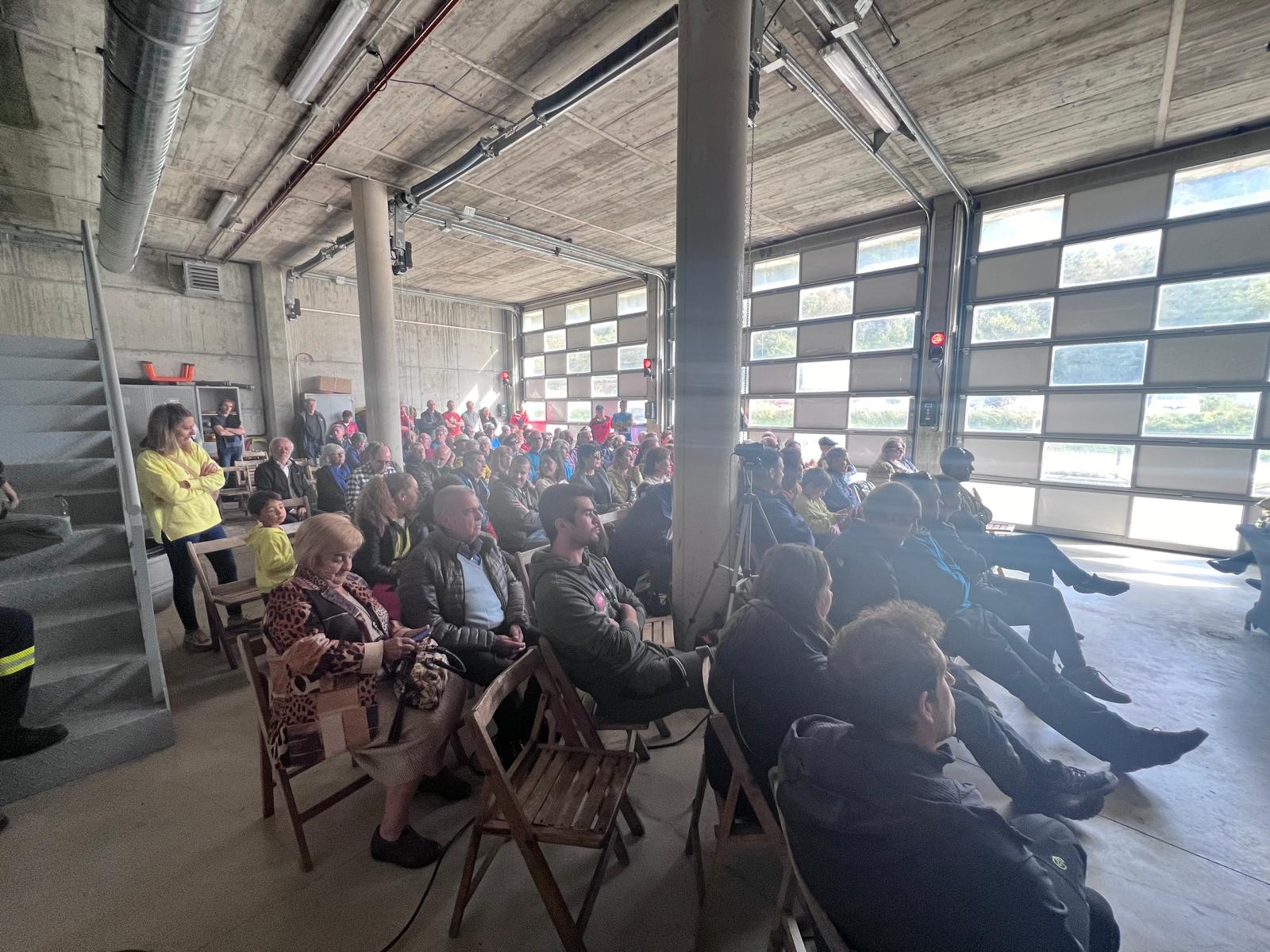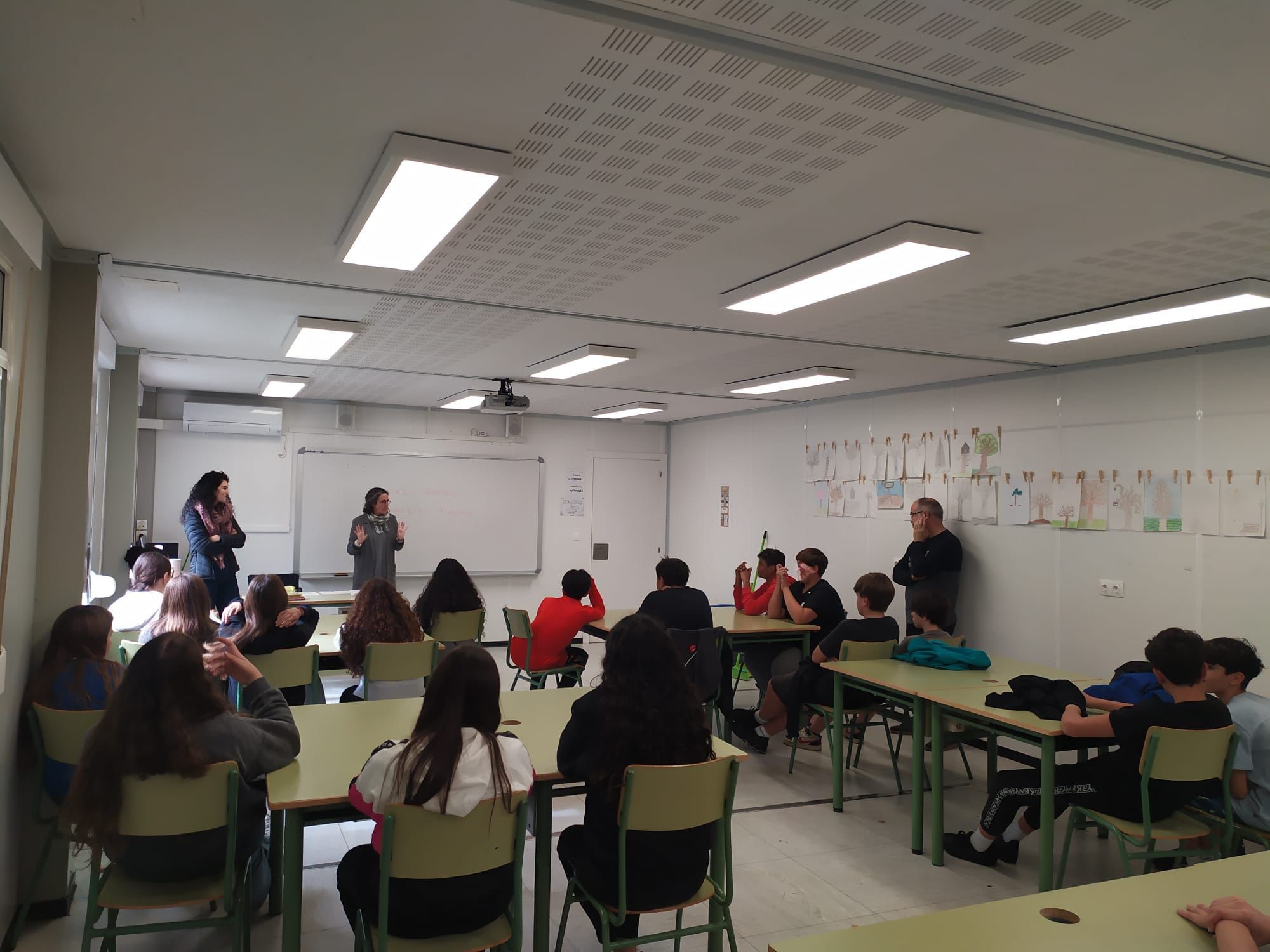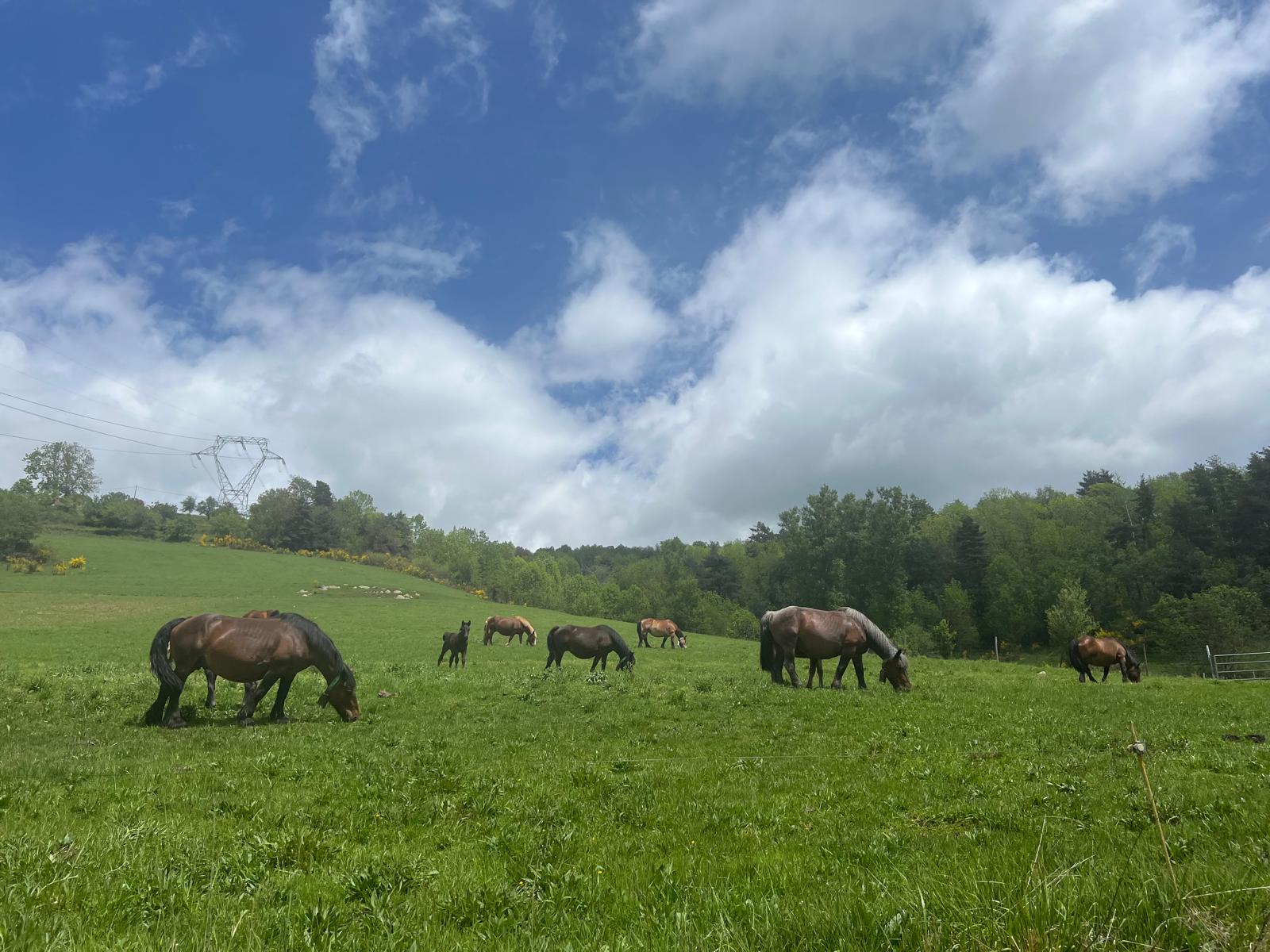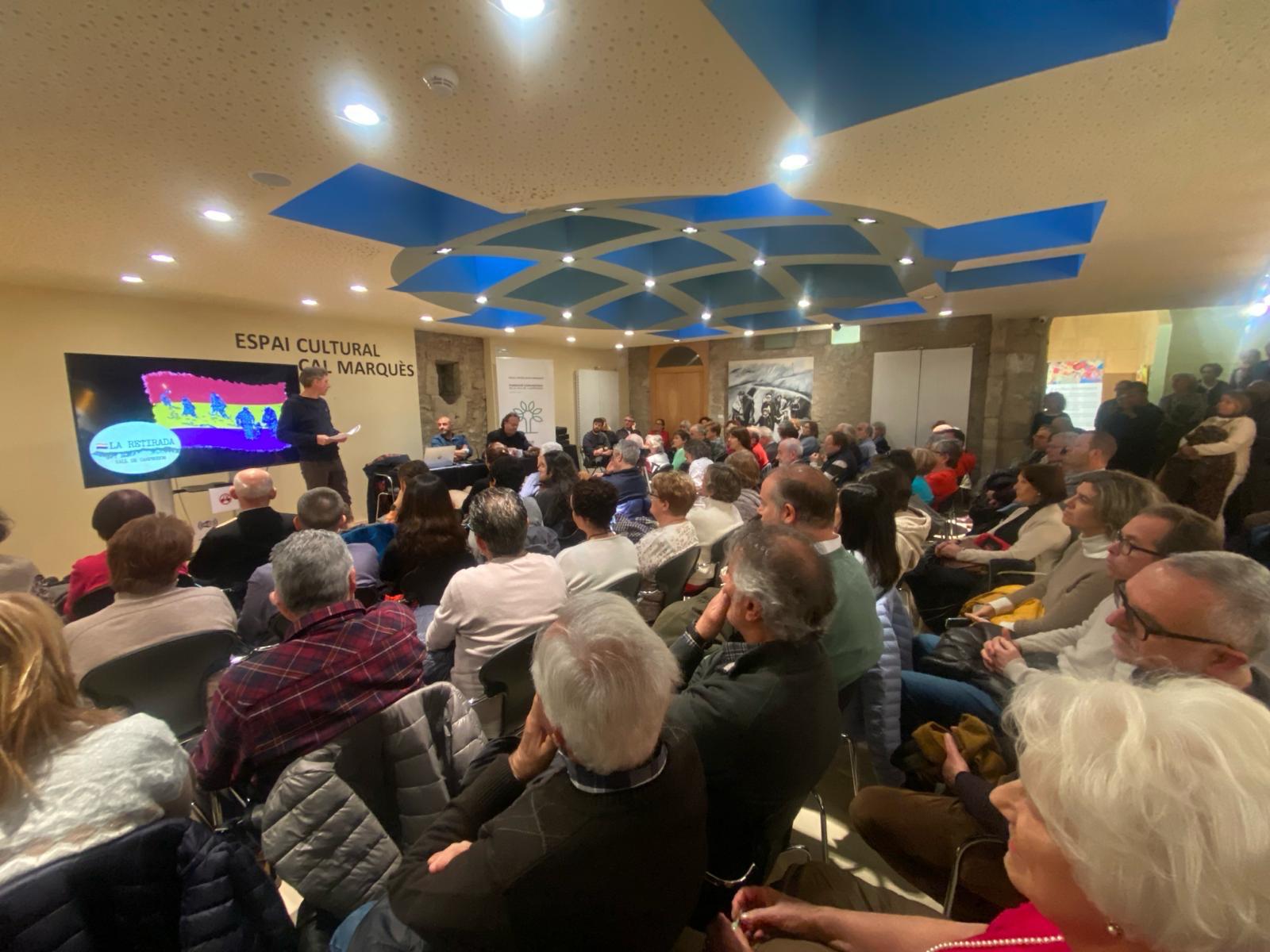Regaining a sense of belonging
Vall de Camprodon Community Foundation
Keep living in the mountains. A new life in the Pyrenees.
"Empowering the Vall de Camprodon community for a sustainable future! The Vall de Camprodon Community Foundation is dedicated to enhancing local well-being by supporting social, cultural, environmental, and economic initiatives. Through collective action, innovation, and solidarity, we work to build a resilient and thriving valley where everyone has the opportunity to grow and succeed. Join us in shaping a brighter future for our community!"
Spain
Local
Camprodon, Molló, Sant Pau de Segúries, Llanars, Vilallonga de Ter and Setcases.
Mainly rural
It refers to other types of transformations (soft investment)
Yes
2024-12-31
No
No
No
As a representative of an organisation
The FCVC is a non-profit organization dedicated to fostering sustainable development and social well-being in the Vall de Camprodon, a rural region in Catalan Pyrenees. Through community-driven actions, the Foundation tackles economic, environmental, social, and educational challenges to enhance local quality of life.
Overall Aim
To empower and strengthen the community by managing resources for social, cultural, educational, and environmental projects that promote sustainability and resilience.
Target groups:
• Children and youth (mentoring, homework support, drug prevention)
• Elderly people (digital literacy, social inclusion, well-being)
• Entrepreneurs and local businesses (training, economic support, sustainable agriculture)
• General Community (cultural activities, bioeconomy, environmental conservation)
Specific Objectives
1. Enhance education through mentoring, academic support, and scholarships.
2. Strengthen economic sustainability via entrepreneurship, local business support, and sustainable tourism.
3. Promote social well-being through intergenerational programs and community-driven support.
4. Advance environmental sustainability via bioeconomy projects, circular agriculture, and responsible forest management.
5. Encourage cultural development and community engagement through local heritage projects and social cohesion initiatives.
Achieved Outcomes
• Mentoring & educational support programs benefiting dozens of students.
• Entrepreneurial training for local business owners and farmers.
• Social inclusion projects connecting youth and elderly through technology training and letter-writing initiatives.
• Environmental initiatives (bioeconomy, sustainable agroforestry) securing government & EUfunding.
• Cultural activities engaging the community in history, traditions, and local heritage.
Through collaboration with volunteers, local entities, and institutions, FCVC is building a stronger, more sustainable, and resilient Valley.
Overall Aim
To empower and strengthen the community by managing resources for social, cultural, educational, and environmental projects that promote sustainability and resilience.
Target groups:
• Children and youth (mentoring, homework support, drug prevention)
• Elderly people (digital literacy, social inclusion, well-being)
• Entrepreneurs and local businesses (training, economic support, sustainable agriculture)
• General Community (cultural activities, bioeconomy, environmental conservation)
Specific Objectives
1. Enhance education through mentoring, academic support, and scholarships.
2. Strengthen economic sustainability via entrepreneurship, local business support, and sustainable tourism.
3. Promote social well-being through intergenerational programs and community-driven support.
4. Advance environmental sustainability via bioeconomy projects, circular agriculture, and responsible forest management.
5. Encourage cultural development and community engagement through local heritage projects and social cohesion initiatives.
Achieved Outcomes
• Mentoring & educational support programs benefiting dozens of students.
• Entrepreneurial training for local business owners and farmers.
• Social inclusion projects connecting youth and elderly through technology training and letter-writing initiatives.
• Environmental initiatives (bioeconomy, sustainable agroforestry) securing government & EUfunding.
• Cultural activities engaging the community in history, traditions, and local heritage.
Through collaboration with volunteers, local entities, and institutions, FCVC is building a stronger, more sustainable, and resilient Valley.
Community Empowerment
Cultural Heritage
Yough opportunities
Sustainability
Environmental Conservation
FCVC embraces the core values of the NEB—sustainability, inclusivity, and aesthetics- by implementing innovative solutions that integrate environmental responsibility, social well-being, and cultural preservation in a rural context.
1. Regenerative land and forest management
Implemented the Circular Valleys Project, combining climate-adaptive agriculture and sustainable forestry to mitigate wildfires, biodiversity loss, and land degradation.
2. Bioeconomy and local resilience
Established the Bioeconomy Specialization Project, securing EU and national funding to support sustainable agroforestry, circular agriculture, and local bio-based industries.
3.Renewable energy and climate adaptation
Partnered with the EuroPACE Foundation to promote solar, biomass, and hydropower solutions, fostering community-led energy autonomy to reduce carbon footprints.
4.Sustainable tourism and cultural preservation
Developed a regenerative tourism model, balancing economic growth with environmental conservation, while preserving historical and cultural identity.
5. Social inclusion and community engagement
Strengthened rural cohesion through intergenerational projects, digital literacy workshops, and youth mentoring, ensuring equal opportunities for all demographics.
Exemplary model for sustainability
The FCVC embodies the NEB vision by creating a people-centered, ecologically responsible, and economically viable approach to rural sustainability. By combining traditional knowledge with innovation, it serves as a scalable model for sustainable rural regeneration across Europe.
1. Regenerative land and forest management
Implemented the Circular Valleys Project, combining climate-adaptive agriculture and sustainable forestry to mitigate wildfires, biodiversity loss, and land degradation.
2. Bioeconomy and local resilience
Established the Bioeconomy Specialization Project, securing EU and national funding to support sustainable agroforestry, circular agriculture, and local bio-based industries.
3.Renewable energy and climate adaptation
Partnered with the EuroPACE Foundation to promote solar, biomass, and hydropower solutions, fostering community-led energy autonomy to reduce carbon footprints.
4.Sustainable tourism and cultural preservation
Developed a regenerative tourism model, balancing economic growth with environmental conservation, while preserving historical and cultural identity.
5. Social inclusion and community engagement
Strengthened rural cohesion through intergenerational projects, digital literacy workshops, and youth mentoring, ensuring equal opportunities for all demographics.
Exemplary model for sustainability
The FCVC embodies the NEB vision by creating a people-centered, ecologically responsible, and economically viable approach to rural sustainability. By combining traditional knowledge with innovation, it serves as a scalable model for sustainable rural regeneration across Europe.
FCVC integrates aesthetics, cultural heritage, and high-quality experiences into its sustainable development model. Through place-based design, cultural revitalization, and community engagement, the project enhances the region’s identity while ensuring a harmonious relationship between people, nature, and culture.
Achievements:
1. Preserving cultural identity and heritage
Developed the “Talking About the Valley” series, engaging locals in discussions on history, traditions, and legends.
Launched “Life Portraits”, documenting the stories of elders to preserve local memory and wisdom.
2. Enhancing public spaces and rural identity
Promotes landscape conservation by integrating sustainable land use with local aesthetics, ensuring that forests, pastures, and villages retain their historical charm.
Supports traditional architecture and craftsmanship in rural planning to maintain the region’s authentic visual identity.
3. Sustainable and inclusive cultural experiences
Organizes community festivals, artistic workshops, and storytelling projects, making culture an accessible, interactive experience.
Strengthened social cohesion through intergenerational projects, such as letter-writing initiatives between youth and seniors, reinforcing emotional connections.
4. Fostering creative expression and innovation
Launched “Tales of a Valley”, encouraging writers and artists to create works inspired by the region, amplifying diverse voices.
Developed eco-friendly tourism that highlights the region’s artistic and natural beauty while promoting sustainable visitor experiences.
Exemplary model for aesthetic and cultural integration:
By blending heritage conservation, artistic innovation, and community-driven design, FCVC sets a replicable standard for rural cultural regeneration in Europe. It demonstrates how design, storytelling, and tradition can transform communities into vibrant, sustainable, and culturally rich spaces.
Achievements:
1. Preserving cultural identity and heritage
Developed the “Talking About the Valley” series, engaging locals in discussions on history, traditions, and legends.
Launched “Life Portraits”, documenting the stories of elders to preserve local memory and wisdom.
2. Enhancing public spaces and rural identity
Promotes landscape conservation by integrating sustainable land use with local aesthetics, ensuring that forests, pastures, and villages retain their historical charm.
Supports traditional architecture and craftsmanship in rural planning to maintain the region’s authentic visual identity.
3. Sustainable and inclusive cultural experiences
Organizes community festivals, artistic workshops, and storytelling projects, making culture an accessible, interactive experience.
Strengthened social cohesion through intergenerational projects, such as letter-writing initiatives between youth and seniors, reinforcing emotional connections.
4. Fostering creative expression and innovation
Launched “Tales of a Valley”, encouraging writers and artists to create works inspired by the region, amplifying diverse voices.
Developed eco-friendly tourism that highlights the region’s artistic and natural beauty while promoting sustainable visitor experiences.
Exemplary model for aesthetic and cultural integration:
By blending heritage conservation, artistic innovation, and community-driven design, FCVC sets a replicable standard for rural cultural regeneration in Europe. It demonstrates how design, storytelling, and tradition can transform communities into vibrant, sustainable, and culturally rich spaces.
FCVC fosters inclusion and social equity by ensuring accessibility, affordability, and participatory governance in all its initiatives. The project creates a people-centered model where education, culture, and economic opportunities are available to all, regardless of age, background, or socioeconomic status.
Achievements:
1. Equal Access to Education & Opportunities
Implemented mentorship programs, homework support, and scholarships to ensure all youth, regardless of income, receive quality education.
Developed entrepreneurial training for small businesses, farmers, and unemployed individuals, supporting economic empowerment.
2. Intergenerational and social inclusion
Launched digital literacy workshops where youth teach seniors how to use technology, fostering mutual learning and reducing isolation.
Created the “Should We Write to Each Other?” initiative, linking volunteers with elderly residents for social connection and emotional support.
3. Affordable and accessible community services
Supports free or low-cost participation in cultural and educational activities to remove economic barriers.
Advocates for affordable housing and economic sustainability, attracting new residents and reversing depopulation trends.
4. Inclusive and participatory governance
Encourages collaborative decision-making, involving citizens, local businesses, and public institutions in community projects.
Works with local and regional governments to shape policies that benefit all demographics, including marginalized groups.
Exemplary model for inclusive development
FCVC proves that rural communities can be models of inclusion by designing programs that empower all generations, remove economic barriers, and promote active citizen participation. This approach can inspire other European rural areas to create more inclusive and accessible communities.
Achievements:
1. Equal Access to Education & Opportunities
Implemented mentorship programs, homework support, and scholarships to ensure all youth, regardless of income, receive quality education.
Developed entrepreneurial training for small businesses, farmers, and unemployed individuals, supporting economic empowerment.
2. Intergenerational and social inclusion
Launched digital literacy workshops where youth teach seniors how to use technology, fostering mutual learning and reducing isolation.
Created the “Should We Write to Each Other?” initiative, linking volunteers with elderly residents for social connection and emotional support.
3. Affordable and accessible community services
Supports free or low-cost participation in cultural and educational activities to remove economic barriers.
Advocates for affordable housing and economic sustainability, attracting new residents and reversing depopulation trends.
4. Inclusive and participatory governance
Encourages collaborative decision-making, involving citizens, local businesses, and public institutions in community projects.
Works with local and regional governments to shape policies that benefit all demographics, including marginalized groups.
Exemplary model for inclusive development
FCVC proves that rural communities can be models of inclusion by designing programs that empower all generations, remove economic barriers, and promote active citizen participation. This approach can inspire other European rural areas to create more inclusive and accessible communities.
Citizen and civil society involvement and Public-Private collaboration
FCVC operates as a public-private collaboration, bringing together citizens, local governments, businesses, and civil society organizations to co-create sustainable solutions. This unique approach ensures that projects are community-driven while benefiting from institutional and private sector support, maximizing impact and long-term sustainability.
How citizens and civil society are involved
1.Co-Design and participatory decision-making
Residents engage in public consultations and collaborative workshops to shape initiatives such as sustainable tourism, cultural preservation, and social support programs.
Partnerships with local municipalities, businesses, and associations ensure broad representation and inclusivity in decision-making.
2. Public-Private collaboration
Works with local and regional governments to secure funding, policy alignment, and institutional support.
Engages businesses, entrepreneurs, and industry experts to provide training, resources, and expertise for economic and social development.
Collaborates with foundations and NGOs to scale projects in education, environmental sustainability, and social welfare.
3. Active participation and volunteering
Citizens lead mentorship, digital literacy, and intergenerational programs, strengthening social ties and inclusion.
Farmers and small businesses actively participate in bioeconomy and circular economy initiatives, fostering local economic resilience.
Impact of Public-Pri and civil society collaboration
Stronger community ownership, ensuring long-term sustainability of projects.
More efficient use of resources, leveraging public funding and private sector expertise.
Inclusive and innovative solutions, combining grassroots engagement with institutional support.
Scalable success, serving as a model for other rural regions, demonstrating how collaborative governance can drive sustainable community development.
FCVC operates as a public-private collaboration, bringing together citizens, local governments, businesses, and civil society organizations to co-create sustainable solutions. This unique approach ensures that projects are community-driven while benefiting from institutional and private sector support, maximizing impact and long-term sustainability.
How citizens and civil society are involved
1.Co-Design and participatory decision-making
Residents engage in public consultations and collaborative workshops to shape initiatives such as sustainable tourism, cultural preservation, and social support programs.
Partnerships with local municipalities, businesses, and associations ensure broad representation and inclusivity in decision-making.
2. Public-Private collaboration
Works with local and regional governments to secure funding, policy alignment, and institutional support.
Engages businesses, entrepreneurs, and industry experts to provide training, resources, and expertise for economic and social development.
Collaborates with foundations and NGOs to scale projects in education, environmental sustainability, and social welfare.
3. Active participation and volunteering
Citizens lead mentorship, digital literacy, and intergenerational programs, strengthening social ties and inclusion.
Farmers and small businesses actively participate in bioeconomy and circular economy initiatives, fostering local economic resilience.
Impact of Public-Pri and civil society collaboration
Stronger community ownership, ensuring long-term sustainability of projects.
More efficient use of resources, leveraging public funding and private sector expertise.
Inclusive and innovative solutions, combining grassroots engagement with institutional support.
Scalable success, serving as a model for other rural regions, demonstrating how collaborative governance can drive sustainable community development.
The FCVC is built on multi-level stakeholder collaboration, integrating local, regional, national, and European actors in both the design and implementation of its projects. This public-private-community approach ensures long-term sustainability, maximizes impact, and strengthens the region’s resilience.
Stakeholder roles and level of involvement
1) Local (Municipalities, Residents, Businesses, NGOs)
Citizens co-design projects through public consultations, while local governments provide funding, infrastructure, and policy support.
Businesses and farmers engage in bioeconomy, tourism, and entrepreneurship initiatives, ensuring local economic sustainability.
NGOs and local associations contribute expertise in education, social welfare, and environmental conservation.
Added Value: Grassroots ownership, ensuring solutions align with real community needs.
2) Regional (Catalan Government, Development Agencies)
Provides policy alignment, funding, and technical expertise, integrating the FCVC’s sustainability projects into broader regional strategies.
Supports bioeconomy and agroforestry initiatives through Resilient Agroforestry Landscapes Program.
Added Value: Strengthens regional collaboration, creating scalable models for rural development.
3)National (Spanish Ministries, Research Institutions, Foundations)
Funds and endorses territorial transformation projects, such as sustainable land management and renewable energy.
Research institutions contribute to data-driven decision-making and innovation in climate adaptation and socio-economic policies.
Added Value: Provides scientific validation, national recognition, and access to financial support.
4) European (EU Funding Programs, Research Networks, International Partners)
Secures funding from EU programs like LIFE eCOadapt50 and NG EU, supporting bioeconomy and climate resilience.ositions FCVC as a model for sustainable rural transformation in EU, increasing visibility and replication potential.
Stakeholder roles and level of involvement
1) Local (Municipalities, Residents, Businesses, NGOs)
Citizens co-design projects through public consultations, while local governments provide funding, infrastructure, and policy support.
Businesses and farmers engage in bioeconomy, tourism, and entrepreneurship initiatives, ensuring local economic sustainability.
NGOs and local associations contribute expertise in education, social welfare, and environmental conservation.
Added Value: Grassroots ownership, ensuring solutions align with real community needs.
2) Regional (Catalan Government, Development Agencies)
Provides policy alignment, funding, and technical expertise, integrating the FCVC’s sustainability projects into broader regional strategies.
Supports bioeconomy and agroforestry initiatives through Resilient Agroforestry Landscapes Program.
Added Value: Strengthens regional collaboration, creating scalable models for rural development.
3)National (Spanish Ministries, Research Institutions, Foundations)
Funds and endorses territorial transformation projects, such as sustainable land management and renewable energy.
Research institutions contribute to data-driven decision-making and innovation in climate adaptation and socio-economic policies.
Added Value: Provides scientific validation, national recognition, and access to financial support.
4) European (EU Funding Programs, Research Networks, International Partners)
Secures funding from EU programs like LIFE eCOadapt50 and NG EU, supporting bioeconomy and climate resilience.ositions FCVC as a model for sustainable rural transformation in EU, increasing visibility and replication potential.
The Vall de Camprodon Community Foundation (FCVC) integrates multiple disciplines to address social, economic, environmental, and cultural challenges.
Disciplines and knowledge fields involved:
- Social sciences and education: Initiatives like mentoring, homework support, and drug prevention engage educators, psychologists, and social workers to promote youth well-being and lifelong learning.
- Environmental and agricultural sciences: Projects like Circular Valleys and Resilient Agroforestry Landscapes involve agronomists, ecologists, and climate experts to develop sustainable farming and forestry models.
- Energy and sustainable development: In collaboration with the EuroPACE Foundation, FCVC promotes renewable energy (biomass, solar, hydro) and sustainable housing strategies.
- Culture and heritage preservation: Historians, writers, and artists contribute to oral history projects (Talking About the Valley, Life Portraits) and local storytelling initiatives (Tales of a Valley).
- Business and innovation: Economists and entrepreneurs lead training programs and Innovall Awards, fostering local economic resilience through circular economy solutions.
- Interdisciplinary collaboration and added value
FCVC facilitates cross-sectoral cooperation, bringing together public institutions, private enterprises, researchers, and local communities. Stakeholders co-design solutions through workshops, mentorships, research studies, and pilot projects. This collaborative model ensures holistic, long-term solutions, balancing social cohesion, sustainability, and economic growth. By fostering innovation, inclusion, and participatory governance, FCVC exemplifies the New European Bauhaus principles, making the Vall de Camprodon a resilient, self-sustaining, and vibrant rural community.
Disciplines and knowledge fields involved:
- Social sciences and education: Initiatives like mentoring, homework support, and drug prevention engage educators, psychologists, and social workers to promote youth well-being and lifelong learning.
- Environmental and agricultural sciences: Projects like Circular Valleys and Resilient Agroforestry Landscapes involve agronomists, ecologists, and climate experts to develop sustainable farming and forestry models.
- Energy and sustainable development: In collaboration with the EuroPACE Foundation, FCVC promotes renewable energy (biomass, solar, hydro) and sustainable housing strategies.
- Culture and heritage preservation: Historians, writers, and artists contribute to oral history projects (Talking About the Valley, Life Portraits) and local storytelling initiatives (Tales of a Valley).
- Business and innovation: Economists and entrepreneurs lead training programs and Innovall Awards, fostering local economic resilience through circular economy solutions.
- Interdisciplinary collaboration and added value
FCVC facilitates cross-sectoral cooperation, bringing together public institutions, private enterprises, researchers, and local communities. Stakeholders co-design solutions through workshops, mentorships, research studies, and pilot projects. This collaborative model ensures holistic, long-term solutions, balancing social cohesion, sustainability, and economic growth. By fostering innovation, inclusion, and participatory governance, FCVC exemplifies the New European Bauhaus principles, making the Vall de Camprodon a resilient, self-sustaining, and vibrant rural community.
The FCVC stands out for its innovative, community-driven approach to rural development, going beyond traditional top-down initiatives. Why It’s Different?
FCVC’s holistic, interdisciplinary, and participatory model transforms the Vall de Camprodon into a sustainable, self-reliant region. Instead of traditional rural aid programs, it creates lasting change by integrating bioeconomy, community empowerment, digital inclusion, and youth-driven innovation—fully aligned with the New European Bauhaus vision.
Innovative approaches:
1) Integrated Bioeconomy Model
Unlike conventional rural development projects that focus on single sectors (e.g., tourism or farming), FCVC combines agriculture, forestry, energy, and local economy in a circular model (Circular Valleys, Resilient Agroforestry Landscapes). This multi-sectoral strategy creates sustainable livelihoods while combating climate change and depopulation.
2) Community participation
Instead of relying on external institutions, FCVC empowers local stakeholders—farmers, youth, businesses, and NGOs—to co-design solutions. The Well-being Study and Talking About the Valley integrate local knowledge with expert insights, ensuring bottom-up decision-making.
3)Rural digital and social innovation
While rural areas often struggle with digital exclusion, FCVC runs intergenerational tech literacy programs (We Help You), digital storytelling (Life Portraits), and online cultural content (YouTube archive of local history), using technology to connect generations and preserve heritage.
4) Education and youth engagement
Unlike standard rural education, FCVC links students with professionals through mentorships and encourages youth-led innovation (Innovall Awards). These programs equip young people with real-world skills, fostering local talent retention.
FCVC’s holistic, interdisciplinary, and participatory model transforms the Vall de Camprodon into a sustainable, self-reliant region. Instead of traditional rural aid programs, it creates lasting change by integrating bioeconomy, community empowerment, digital inclusion, and youth-driven innovation—fully aligned with the New European Bauhaus vision.
Innovative approaches:
1) Integrated Bioeconomy Model
Unlike conventional rural development projects that focus on single sectors (e.g., tourism or farming), FCVC combines agriculture, forestry, energy, and local economy in a circular model (Circular Valleys, Resilient Agroforestry Landscapes). This multi-sectoral strategy creates sustainable livelihoods while combating climate change and depopulation.
2) Community participation
Instead of relying on external institutions, FCVC empowers local stakeholders—farmers, youth, businesses, and NGOs—to co-design solutions. The Well-being Study and Talking About the Valley integrate local knowledge with expert insights, ensuring bottom-up decision-making.
3)Rural digital and social innovation
While rural areas often struggle with digital exclusion, FCVC runs intergenerational tech literacy programs (We Help You), digital storytelling (Life Portraits), and online cultural content (YouTube archive of local history), using technology to connect generations and preserve heritage.
4) Education and youth engagement
Unlike standard rural education, FCVC links students with professionals through mentorships and encourages youth-led innovation (Innovall Awards). These programs equip young people with real-world skills, fostering local talent retention.
FCVC applies a participatory, interdisciplinary, and sustainability-driven approach to address rural challenges. Our methodology ensures that projects are community-led, inclusive, and scalable, aligning with the NEB principles.
1. Community-Based and participatory approach
Bottom-up Governance: Projects are designed with and for the local community, ensuring active participation from residents, schools, businesses, and public institutions.
Co-creation and stakeholder engagement: We organize brainstorming sessions, workshops, and roundtable discussions to identify needs and solutions collaboratively (e.g., Tourism Project, Well-being Study).
2. Interdisciplinary and multi-sectoral collaboration
We integrate social sciences, education, environmental science, economy, and culture to create holistic solutions.
Experts from academia, local authorities, businesses, NGOs, and grassroots organizations work together to design and implement initiatives.
3. Evidence-based and data-driven decision-making
We conduct research and diagnostics (Well-being Study, Bioeconomy reports) to assess local needs and develop targeted solutions.
Projects are continuously monitored and adapted based on feedback and measurable impact indicators.
4. Sustainability and innovation as core principles
Our initiatives promote bioeconomy, circular economy, and climate resilience (Circular Valleys Project, Resilient Agroforestry Landscapes).
We integrate digital solutions and intergenerational learning (We Help You, Life Portraits).
5. Capacity building and knowledge transfer
We empower youth, entrepreneurs, and farmers through training, mentorship, and funding opportunities (Innovall Awards, Entrepreneurship Workshops).
Educational programs foster local talent retention and economic sustainability.
This methodology fosters innovation, inclusivity, and long-term rural resilience, ensuring local empowerment and sustainable development in Vall de Camprodon.
1. Community-Based and participatory approach
Bottom-up Governance: Projects are designed with and for the local community, ensuring active participation from residents, schools, businesses, and public institutions.
Co-creation and stakeholder engagement: We organize brainstorming sessions, workshops, and roundtable discussions to identify needs and solutions collaboratively (e.g., Tourism Project, Well-being Study).
2. Interdisciplinary and multi-sectoral collaboration
We integrate social sciences, education, environmental science, economy, and culture to create holistic solutions.
Experts from academia, local authorities, businesses, NGOs, and grassroots organizations work together to design and implement initiatives.
3. Evidence-based and data-driven decision-making
We conduct research and diagnostics (Well-being Study, Bioeconomy reports) to assess local needs and develop targeted solutions.
Projects are continuously monitored and adapted based on feedback and measurable impact indicators.
4. Sustainability and innovation as core principles
Our initiatives promote bioeconomy, circular economy, and climate resilience (Circular Valleys Project, Resilient Agroforestry Landscapes).
We integrate digital solutions and intergenerational learning (We Help You, Life Portraits).
5. Capacity building and knowledge transfer
We empower youth, entrepreneurs, and farmers through training, mentorship, and funding opportunities (Innovall Awards, Entrepreneurship Workshops).
Educational programs foster local talent retention and economic sustainability.
This methodology fosters innovation, inclusivity, and long-term rural resilience, ensuring local empowerment and sustainable development in Vall de Camprodon.
The FCVC has developed a scalable and adaptable model that can be replicated in other rural regions across Europe. Our methodology, processes, and key initiatives provide valuable frameworks for sustainable, community-driven development.
1. Community-Led participatory approach
- Replicable Model: The bottom-up governance approach, where local residents, businesses, and institutions co-design solutions, can be applied to any rural or urban community seeking greater self-sufficiency and resilience.
- Key processes: Community forums, brainstorming sessions, and participatory planning workshops foster stakeholder engagement and collective decision-making.
- Transferability: Ideal for municipalities, grassroots organizations, and social enterprises aiming to enhance civic engagement.
2. Sustainable bioeconomy and circular economy practices
- Replicable model: The Circular Valleys Project and Resilient Agroforestry Landscapes provide a tested framework for rural areas to develop sustainable agriculture, forestry, and energy solutions.
- Key processes: Integrating climate adaptation strategies, sustainable land use, and biodiversity conservation.
- Transferability: Suitable for regions facing depopulation, economic decline, or environmental degradation.
3. Education and talent retention programs
- Replicable model: Programs like mentoring, homework support, and entrepreneurship training empower youth and professionals in rural settings.
- Key learnings: Providing career guidance, skills training, and scholarships boosts local retention and economic development.
-Transferability: Can be adapted by rural schools, vocational training centers, and local businesses to support workforce development.
4. Digital inclusion and social innovation
- Replicable model: Intergenerational digital literacy programs like We Help You can bridge the digital divide in rural areas.
- Key learnings: Combining education with technology enhances
1. Community-Led participatory approach
- Replicable Model: The bottom-up governance approach, where local residents, businesses, and institutions co-design solutions, can be applied to any rural or urban community seeking greater self-sufficiency and resilience.
- Key processes: Community forums, brainstorming sessions, and participatory planning workshops foster stakeholder engagement and collective decision-making.
- Transferability: Ideal for municipalities, grassroots organizations, and social enterprises aiming to enhance civic engagement.
2. Sustainable bioeconomy and circular economy practices
- Replicable model: The Circular Valleys Project and Resilient Agroforestry Landscapes provide a tested framework for rural areas to develop sustainable agriculture, forestry, and energy solutions.
- Key processes: Integrating climate adaptation strategies, sustainable land use, and biodiversity conservation.
- Transferability: Suitable for regions facing depopulation, economic decline, or environmental degradation.
3. Education and talent retention programs
- Replicable model: Programs like mentoring, homework support, and entrepreneurship training empower youth and professionals in rural settings.
- Key learnings: Providing career guidance, skills training, and scholarships boosts local retention and economic development.
-Transferability: Can be adapted by rural schools, vocational training centers, and local businesses to support workforce development.
4. Digital inclusion and social innovation
- Replicable model: Intergenerational digital literacy programs like We Help You can bridge the digital divide in rural areas.
- Key learnings: Combining education with technology enhances
FCVC demonstrates that global challenges can be solved through localized, community-led action. Our scalable and interdisciplinary approach makes the Vall de Camprodon a model for sustainable rural transformation, aligning with the New European Bauhaus values of beauty, sustainability, and inclusion.
1. Climate change and environmental sustainability
Climate change and biodiversity loss threaten ecosystems.
Local Solution: FCVC’s Circular Valleys Project and Resilient Agroforestry Landscapes promote sustainable land use, reforestation, and climate adaptation. Renewable energy initiatives (biomass, hydro, solar) reduce fossil fuel dependency and support a self-sufficient rural energy model.
2. Rural depopulation and economic decline
Many rural areas are losing population due to limited jobs and services.
Local Solution: FCVC boosts local employment through mentorship programs, scholarships (Innovall Awards), entrepreneur training, and sustainable tourism initiatives. These create opportunities for youth, fostering economic resilience and preventing migration.
3. Social inequality and digital divide
Rural areas often lack access to education and technology.
Local Solution: The “We Help You” program provides digital literacy training for the elderly, reducing exclusion. Homework support and mentoring programs ensure equal learning opportunities, regardless of socio-economic background.
4. Food security and sustainable agriculture
Industrialized food systems harm the environment and local economies.
Local Solution: FCVC promotes local, sustainable agriculture by reviving traditional crops, supporting small farmers, and creating food sovereignty initiatives to ensure long-term sustainability.
5. Cultural erosion and loss of heritage
Many regions struggle to preserve their traditions.
Local Solution: FCVC’s "Talking About the Valley" and "Life Portraits" projects
FCVC provides a scalable, community-led model for tackling global challenges.
1. Climate change and environmental sustainability
Climate change and biodiversity loss threaten ecosystems.
Local Solution: FCVC’s Circular Valleys Project and Resilient Agroforestry Landscapes promote sustainable land use, reforestation, and climate adaptation. Renewable energy initiatives (biomass, hydro, solar) reduce fossil fuel dependency and support a self-sufficient rural energy model.
2. Rural depopulation and economic decline
Many rural areas are losing population due to limited jobs and services.
Local Solution: FCVC boosts local employment through mentorship programs, scholarships (Innovall Awards), entrepreneur training, and sustainable tourism initiatives. These create opportunities for youth, fostering economic resilience and preventing migration.
3. Social inequality and digital divide
Rural areas often lack access to education and technology.
Local Solution: The “We Help You” program provides digital literacy training for the elderly, reducing exclusion. Homework support and mentoring programs ensure equal learning opportunities, regardless of socio-economic background.
4. Food security and sustainable agriculture
Industrialized food systems harm the environment and local economies.
Local Solution: FCVC promotes local, sustainable agriculture by reviving traditional crops, supporting small farmers, and creating food sovereignty initiatives to ensure long-term sustainability.
5. Cultural erosion and loss of heritage
Many regions struggle to preserve their traditions.
Local Solution: FCVC’s "Talking About the Valley" and "Life Portraits" projects
FCVC provides a scalable, community-led model for tackling global challenges.
Impacts of FCVC’s projects:
The FCVC has achieved significant social, environmental, economic, and cultural impacts, directly benefiting local residents while fostering long-term sustainability in the region.
Key achievements:
- Social and educational impact
Mentoring Program: Over 30 students per year connected with professionals, improving career guidance and youth retention.
Homework Support: Provided equal educational opportunities in collaboration with schools, Cáritas, and the Red Cross.
Youth Without Drugs: Engaged 3rd and 4th-year students in preventive awareness sessions to reduce substance abuse.
We Help You: Enabled elderly residents to master digital tools, fostering intergenerational learning.
- Economic and entrepreneurial growth
Training for Future Entrepreneurs: Equipped small business owners and farmers with financial, tax, and business planning skills.
Innovall Awards: Provided scholarships for youth-led sustainability projects, encouraging innovation in rural development.
- Environmental and bioeconomy results
Circular Valleys Project: Secured €175,073.42 in funding to implement sustainable agriculture and forestry models, ensuring economic and environmental resilience.
Resilient Agroforestry Landscapes: Selected as a pilot program by the Catalan Government, attracting European NG funds.
Sustainable Energy Model: Developed strategies for local energy autonomy (biomass, hydro, solar), positioning the Valley as a green, self-sufficient territory.
- Cultural and social cohesion
Talking About the Valley: Hosted 19 roundtable discussions with 80–100 participants per session, preserving local history and traditions.
Life Portraits & Tales of a Valley: Collected and published personal stories, fostering community identity and generational exchange.
Beneficiaries
- Direct: Students, elderly, farmers, entrepreneurs, local businesses, and volunteers (~500 people annually).
- Indirect: Entire Vall de Camprodon (~4,470 people)
The FCVC has achieved significant social, environmental, economic, and cultural impacts, directly benefiting local residents while fostering long-term sustainability in the region.
Key achievements:
- Social and educational impact
Mentoring Program: Over 30 students per year connected with professionals, improving career guidance and youth retention.
Homework Support: Provided equal educational opportunities in collaboration with schools, Cáritas, and the Red Cross.
Youth Without Drugs: Engaged 3rd and 4th-year students in preventive awareness sessions to reduce substance abuse.
We Help You: Enabled elderly residents to master digital tools, fostering intergenerational learning.
- Economic and entrepreneurial growth
Training for Future Entrepreneurs: Equipped small business owners and farmers with financial, tax, and business planning skills.
Innovall Awards: Provided scholarships for youth-led sustainability projects, encouraging innovation in rural development.
- Environmental and bioeconomy results
Circular Valleys Project: Secured €175,073.42 in funding to implement sustainable agriculture and forestry models, ensuring economic and environmental resilience.
Resilient Agroforestry Landscapes: Selected as a pilot program by the Catalan Government, attracting European NG funds.
Sustainable Energy Model: Developed strategies for local energy autonomy (biomass, hydro, solar), positioning the Valley as a green, self-sufficient territory.
- Cultural and social cohesion
Talking About the Valley: Hosted 19 roundtable discussions with 80–100 participants per session, preserving local history and traditions.
Life Portraits & Tales of a Valley: Collected and published personal stories, fostering community identity and generational exchange.
Beneficiaries
- Direct: Students, elderly, farmers, entrepreneurs, local businesses, and volunteers (~500 people annually).
- Indirect: Entire Vall de Camprodon (~4,470 people)

